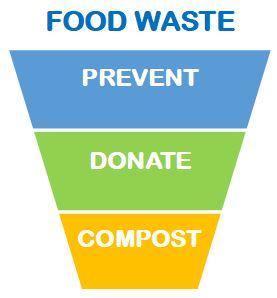Food Waste Recovery and Composting
Food Waste Recovery and Composting
Food waste makes up an estimated 15% of all landfilled material in Benton County, and food waste accounts for more than 20% of landfilled material from commercial sources (DEQ, Downstate 2016). It is important to compost any food waste that cannot be prevented or donated. Composting food waste reduces carbon emissions and produces nutrient-rich soil amendment.

Set Up Food Waste Collection
Contact Republic Services to set up food waste collection for your business. Ask about options for container sizes and collection frequency to best fit your business’ needs. Food waste should be collected at least weekly to prevent odor and pest issues.
Set Up Your Space
A well-organized space for food waste collection makes composting clean, easy, and effective.
Outdoor Collection Containers
Outdoor food waste collection containers are provided by Republic Services. Make sure that these containers are accessible and well-labeled to ensure no trash or contamination.
Indoor Containers
Small indoor containers should be placed where food waste is generated. Be mindful of the potential for contamination when placing indoor collection containers. Food waste is also heavy, so make sure that the indoor containers can be easily emptied into the outdoor collection containers.
Typical indoor container locations:
- Back-of-house
- kitchen and food preparation areas
- dish-washing station
- Front-of-house food waste collection may have higher contamination, where customers are responsible for placing source-separated food waste into the collection container. Some businesses offer bussing stations instead of collection containers, where food waste is separated from trash and recycling back-of-house by staff.
Typical container types include:
- Buckets – 5 gallons or less
- Use at point of back-of-house food waste separation
- Old food storage buckets work well
- Can often nest into larger narrow containers for ease of separating trash and compost in one location, saving space
- Buckets can be easier to lift, clean, and dump into outdoor collection containers than larger containers.
- Narrow containers – 25 gallons or less
- Can also be used at point of back-of-house food waste separation
- Can be used to temporarily collect food waste from buckets before bringing to the outdoor food waste collection container
- These larger containers are much heavier, and can be more difficult to lift, clean, and dump into outdoor collection containers than buckets. These containers should not be filled completely to help reduce weight.
Cleaning:
It is important to keep indoor containers clean. Make sure you have enough space and the right equipment to clean the containers you choose to use.
Bags, including certified compostable bags, are not accepted at our local compost facility, and should not be placed in your outdoor food waste collection container.
Signage
Each container should be well-labeled with stickers and signage. It should be very clear what materials go into each container.
Train Staff
Staff training is a very important step in setting up a food waste composting system. Each staff member should be trained on:
1. What to put in your Food Waste Container?
Accepted Materials – All Food Waste
- Dairy Products – Cheese, Yogurt, Etc.
- Coffee Filters and Coffee Grounds
- Tea Bags and Tea Leaves
- Meat, Fish, Poultry, and Bones
- Fruit and Vegetable Scraps
- Leftovers
- Pumpkins
- Bread, Pasta, and Grains
- Eggshells and Nutshells
Materials Which are NOT Accepted
- Plastics of any kind
- Certified compostable plastics
- Compostable service ware
- Paper, napkins, tissues
- Animal waste
- Animal carcasses
- Grease and Oil
- Liquids
- Treated Wood
- Dirt, Grass clippings, Weeds, Leaves, Tree branches, Twigs, Roots, Garden Debris
- Houseplants
2. Process to Empty Indoor Containers
Do not fill containers too full, because food waste is heavy. Lift containers carefully and consider working in pairs to empty larger indoor containers into the outdoor collection containers.
3. Cleaning Containers
To prevent odors, flies, and pests, clean containers regularly (daily cleaning is recommended). Use the dump sink instead of the food prep sink for cleaning. Some dishwashers can clean buckets. When cleaning larger containers, rinse water should never be emptied into the storm drain, and instead use a sanitary sewer drain.
Examples of Food Waste Recovery and Composting
Content Source: City of Portland
